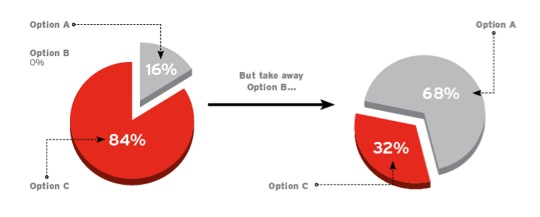We like to think we know what we want all of the time. But when presented with a number of complex choices, decision-making can get hard. When consumers are bombarded with choice, how do you increase sales? You use the power of the inferior to sway superior choices.
The power of the inferior
If you offer an all-expenses paid weekend to Rome or an all-expenses weekend to Paris, what do customers choose?
It’s a hard choice. But if, for the same price, you offer an all-expenses paid weekend to Rome or a weekend to Rome but customers have to buy their own breakfast and dinner, the choice is easier because one is notably inferior.
Take this subscription deal:
- Option A — Magazine.com subscription $59. One year subscription includes access to all articles since 2000.
- Option B — Print subscription $125. One year subscription to the print edition of the magazine.
- Option C — Print & web subscription $125. One year subscription to the print edition and online access to all articles since 1997.
Why offer Option B when option C is clearly superior? Behavioural economist, Dan Ariely explains.
What does this say for decision-making?
While option B appears useless, it’s actually not because it helps people figure out what they want by identifying the inferior. Relative to Option B, Option C looks great. But take away Option B and results sway toward the cheaper option. Moral? Customer choice is susceptible to external influence.









